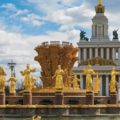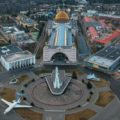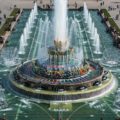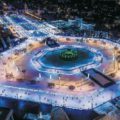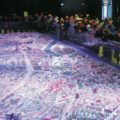The Exhibition of Achievements of National Economy (abbreviated in Russian as VDNH) is a symbol of the Soviet era and the display of new technologies.
The Exhibition of Achievements of National Economy (VDNH) is the largest trade show, museum, and entertainment complex in the world. Annually, 33 million guests visit VDNH to have a good time, learn something new, and see the legendary monuments of the Soviet era with their own eyes.
Pride of the Soviet Union
The history of this popular Moscow venue began on August 1, 1939: the grand opening of the All-Union Agricultural Exhibition (the first name of VDNH) took place on this day. The project struck the imagination: a whole exhibition city had grown on the wasteland in the northeastern part of Moscow within four years. The territory of the exhibition is a favorite leisure area for Moscow residents, especially because after the World War II and up to the 1990s, it expanded with new pavilions and hosted the most interesting events. In 1958, the area received its modern name — the Exhibition of Achievements of National Economy. In the 1990s, VDNH lost its popularity. A large-scale renovation began in 2014, and on its 80th anniversary in 2019, VDNH restored not only iconic architectural objects, but also opened new educational and cultural spaces.
Soviet masterpieces
The venue embraces 49 cultural heritage sites. Visitors see one of them right at the central entrance: this is a triumphal arch, a symbol of the victory of the Soviet Union in the Great Patriotic War. However, the arch is decorated with an absolutely peaceful sculpture “Tractor Driver and Collective Farm Girl” also depicted on the official VDNH logo. From the arch, one can walk along the alley to the Central Pavilion, another symbol of the exhibition. The pavilion with a spire is as high as 97 meters. The stepped design looks austere, impressive, and solemn, a great example of the Stalinist architecture.
Behind the Central Pavilion, there is the Friendship of Peoples Square with a fountain bearing the same name. The latter can be called the most famous object of VDNH. On the fountain, 16 female sculptures made of bronze and covered with gold leaf froze in a circle dance around a huge sheaf. Each sculpture symbolizes one of the Soviet republics, including the Karelo-Finnish Soviet Socialist Republic, which had this status up to 1956. We know the names of several models. Ballerina Virve Kiple-Parsadanyan posed for Estonia’s sculpture, while pianist Gozel Annamamedova personifies Turkmenistan: in the 1950s, they were both ordinary Moscow students. In contrast, the sculpture of Georgia has the face of Rodam Amirejibi, the first beauty of Tbilisi, a real Georgian princess and the wife of prominent poet Mikhail Svetlov.
On the Central Alley, there is also the Stone Flower Fountain, inspired by the images Ural Tales by Pavel Bazhov. The huge flower consists of large concrete slabs lined with multicolored smalt. Since the fountain used to jet water to the music from Dmitri Shostakovich’s Festive Overture and was illuminated at night, one can say that it was the first light and music fountain in the USSR.
The sculpture “Worker and Kolkhoz Woman” is one of the symbols of the Soviet era and the logo of Mosfilm film studio. This monument created by Vera Mukhina adorned the USSR pavilion at the International Exhibition in Paris in 1937, and then was moved to VDNH. However, instead of the 34-meter pedestal designed initially, the monument was put on a 10-meter “stump”, as Vera Mukhina, the sculptor, called it. After the restoration in 2009, “Worker and Kolkhoz Woman” rises above the pavilion at the height intended by the author. The lecture hall and the roof of the pavilion host workshops, seminars, and concerts.
Technology, culture, and crafts
Visitors come to VDNH with their own purpose. Someone comes without any intention, but finds new hobbies and interests there. There is no surprise, considering amazing educational and entertainment spaces scattered on the vast territory of the exhibition.
The Cosmonautics Aviation Center demonstrates the long way Russia has come in the development of technology — literally from tractors to moon rovers. The center’s predecessor, the Mechanization pavilion demonstrated a conveyor along which agricultural machines were moving. At present, the Cosmonautics and Aviation Center has the models of Lunokhod-2, the Mir space station, the Almaz orbital station, spacesuits, and astronauts’ equipment. The area “Cosmodrome of the Future” is equipped with game simulators, which enable visitors to feel what it is like to land on the moon. The Museum of Cosmonautics has 100,000 exhibits, and a model of the first artificial Earth satellite is one of these.
The former Agriculture pavilion is the museum of Slavic writing “Slovo” (“a word” in Russian). The exposition introduces the visitors to the Glagolitic and Cyrillic alphabets and reflects the development of Slavic writing from the 9th century to the present day. The guests can literally travel in time: from a monastery cell to the first Russian printing house, from a lesson at a zemstvo school to the church, where one can try to decode ancient Russian graffiti.
Those who like to work with their hands will definitely enjoy a visit to the Park of Crafts — a group of pavilions dedicated to manual work and handicrafts. There are workshops for every taste, from furniture to confectionery. There is even a real farm, where one can pet sheep, goats, and donkeys and learn how farmers take care of animals.
The Moskvarium Center for Oceanography and Marine Biology shows its guests the world that is usually hidden under the ocean waves. Over 12,000 marine creatures live here, for instance, sharks, octopuses, rays, caimans, seals, and echinoderms. Kids and adults can attend a show with dolphins, sea lions, and killer whale˚. In addition to this, the Center has a lecture hall and an interactive multimedia exhibition where you can marvel at the species that lived in the ocean during the dinosaur era.
The futuristic Robostation pavilion has the largest interactive exhibition of achievements in robotics in Russia. There you can see robots dance, play chess, learn about the underwater robots involved in the search for the Titanic, and even create amazing inventions with your own hands at open workshops.
The Moscow Model pavilion depicts 23,000 objects located inside the Boulevard and Garden Rings, identical to the real ones with one remark — the scale is 1:400. The models recreate not only architectural details, but landscape features as well and the lighting simulates the day and night under various weather conditions.
The pavilion “Fairy Tales Theater” is kids’ favorite. Open the door and find yourself in a real fairy tale, since multimedia technologies enable the audience not just to watch the performance, but to take part in it and even change the plot.
In addition to this, VDNH offers some seasonal activities: in winter, it has the largest ice skating rink in Moscow, which can accommodate over 4,500 visitors, and the Green Theater works in summer. This theater is as old as the very first exhibition, which opened in 1939. Jazz and art festivals are now held on the stage in the middle of the park, where Leonid Utyosov and Klavdiya Shulzhenko once sang.
As we can see, the legendary Exhibition of Achievements of the National Economy accumulates all the best: technology, art, sports, and entertainment for the whole family.
Marina Zhukova, Tatiana Borisova
Photos are provided by VDNH press service

